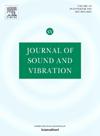基于格林函数的轴向旋转钻柱系统强迫振动分析
IF 4.9
2区 工程技术
Q1 ACOUSTICS
引用次数: 0
摘要
钻柱是石油工业中重要的结构部件,在作业过程中会受到高温、高压、扭力、钻井液、钻头摩擦相互作用等多种影响,特别是钻头摩擦相互作用会产生复杂的摩擦力矩或摩擦力,从而引起钻柱的粘滑振动和复杂的非线性振动。本文建立了一个系统新颖的钻柱非线性动力学模型,该模型考虑了轴向运动和旋转运动、钻头处的摩擦相互作用以及钻井液内外循环的综合影响。为了研究轴向运动和自旋运动的联合效应,对轴向运动和自旋钻柱的退化线性动力学模型进行了解析研究。本工作的一个新颖之处在于,首先考虑了轴向运动和旋转运动以及内部和外部钻井液循环对钻柱强迫振动的影响。利用扩展汉密尔顿原理建立了钻柱的系统非线性动力学模型。然后应用格林函数和拉普拉斯变换得到振动方程的基本解,该基本解具有通用性,可以适应各种边界条件。在数值结果部分,通过与文献中已有结果的比较,验证了所提方法的有效性。讨论了轴向移动速度、自旋速度、钻井液内部流速、黏性阻尼系数等因素对钻柱振动响应的影响,为钻柱振动控制提供了理论依据。本文章由计算机程序翻译,如有差异,请以英文原文为准。
Forced vibration analysis of an axially moving and spinning drill string system based on Green’s functions
A drill string is a critical structural component in the petroleum industry, subject to various influences such as high temperature, high pressure, torsional forces, drilling fluids, and frictional interaction at the drill bit during operation, especially the frictional interaction at the drill bit, which produces complex friction torques or forces that could induce stick-slip vibrations and complicated nonlinear vibrations of the drilling string. This paper formulated a systematically novel nonlinear dynamic model of a drill string that considered combined effects of axially moving and spinning motions, the frictional interaction at the drill bit, and internal and external drilling fluid circulation. For the aim of investigating the combined effects of axially moving and spinning motions, a degenerated linear dynamic model of the axially moving and spinning drill string (ASDS) is studied analytically. A novel aspect of this work is that firstly the effects of axially moving and spinning motions, with both internal and external drilling fluid circulation on forced vibration of the drill string are all considered. The extended Hamilton principle is used to establish the systematical nonlinear dynamic model of the drill string. The Green’s function and the Laplace transform are then applied to obtain the fundamental solution of the vibration equation, which is general and can be adapted to various boundary conditions. In the numerical results section, the effectiveness of the proposed method is validated by comparing it with existing results from references. The influence of factors such as axially moving velocity, spinning velocity, internal drilling fluid velocity, and the viscous damping coefficient on the vibration response of the drill string is discussed, providing a theorewtical basis for the vibration control of drill strings.
求助全文
通过发布文献求助,成功后即可免费获取论文全文。
去求助
来源期刊

Journal of Sound and Vibration
工程技术-工程:机械
CiteScore
9.10
自引率
10.60%
发文量
551
审稿时长
69 days
期刊介绍:
The Journal of Sound and Vibration (JSV) is an independent journal devoted to the prompt publication of original papers, both theoretical and experimental, that provide new information on any aspect of sound or vibration. There is an emphasis on fundamental work that has potential for practical application.
JSV was founded and operates on the premise that the subject of sound and vibration requires a journal that publishes papers of a high technical standard across the various subdisciplines, thus facilitating awareness of techniques and discoveries in one area that may be applicable in others.
 求助内容:
求助内容: 应助结果提醒方式:
应助结果提醒方式:


